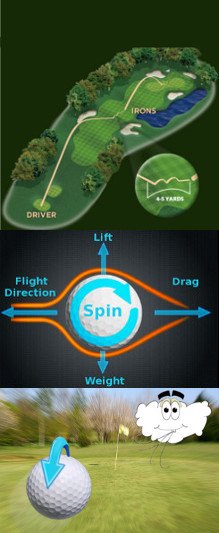- Be more aggressive when the course is soft. If you are playing a course which has recently been soaked by rain, you can play a little more aggressively because the ball is unlikely to bounce into the water. Your shots will usually come to a rest pretty quickly after they land on a soft course, so having the ball bounce forward (or backward) into the water isn’t much of a concern. You don’t want to be reckless in these conditions, of course, but you should be able to take more aggressive lines than you would use when the course is dry.
- Play with plenty of margin in the wind. The combination of a shot over water and a strong breeze is a recipe for golf disaster. It is always hard to judge your shots when the wind is blowing, and you can’t afford to make a mistake when there is water in the area. There isn’t anything you can do about the wind, and you can’t get rid of the water, so the best bet is to take the safest possible line. Pick out a target that will keep your ball safely away from the water, even if that means leaving the shot farther from the hole itself. You can’t predict the behavior of the wind perfectly, so it’s always a wise ideal to play with as much margin for error as possible in this situation.
- Watch for too much backspin. This is another point which usually comes into play when the course is soft. On soft greens, your approach shots are likely to dig into the turf when they land, and the backspin on the ball may cause your shot to spin back toward the front of the putting surface. If the front of the green is guarded by water, spinning the shot back too far might cause you to wind up in the hazard. If you are worried about this outcome while playing an approach shot, try using an extra club and playing the ball in low to take some spin off the shot.

The course conditions you face on any given day will play a role in how you deal with water hazards. It is always your job as a golfer to respond to course conditions and make adjustments as necessary. This job is particularly important when playing near water, as a slight miscalculation could result in sending your golf ball to the bottom of the pond.
While there are too many course conditions possible to list them all here, the points below highlight some key tips for common conditions you are likely to encounter at one point or another.
You should always be considering course conditions anytime you are on the course. Rarely will you play two rounds in exactly the same conditions, so you should always be adapting your game to match with the requirements of the course. With regard to water hazards, think about how the conditions will affect your shots and then make your plans accordingly.





